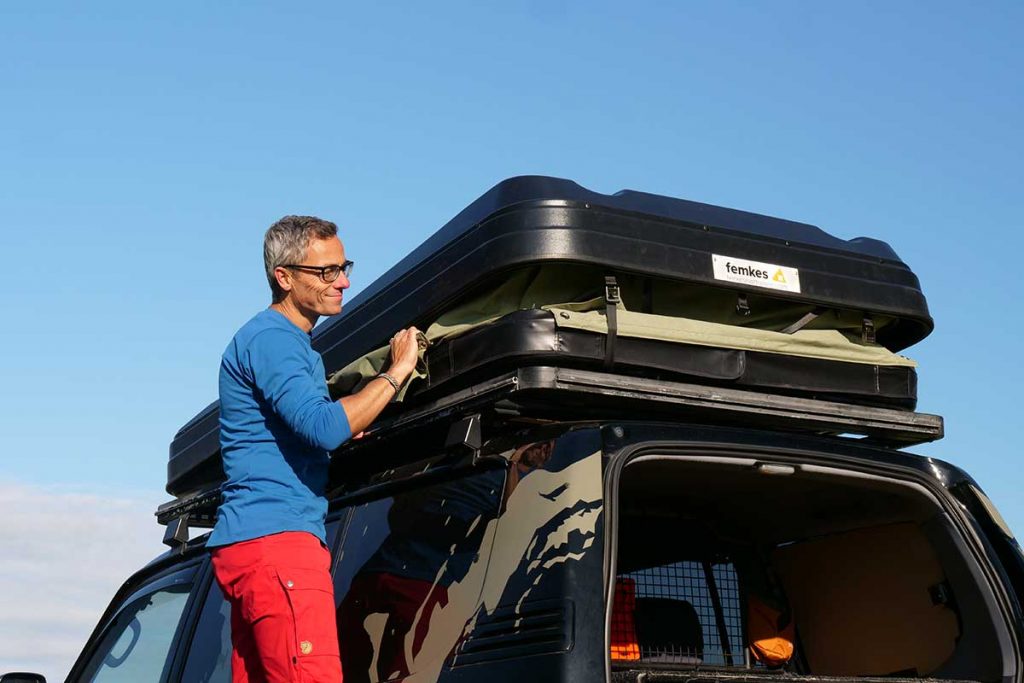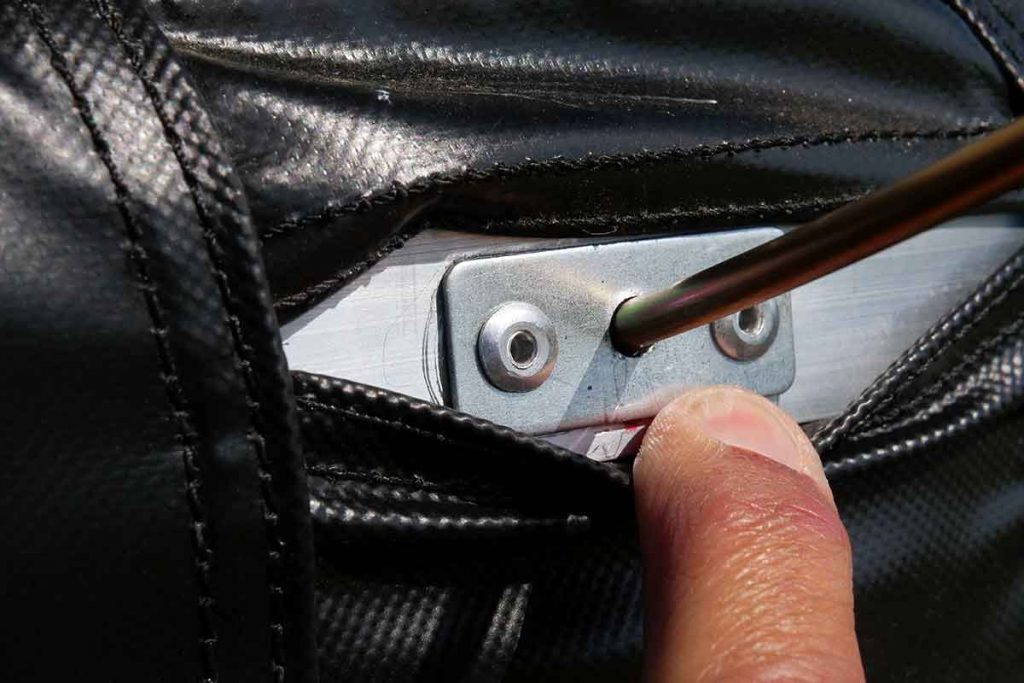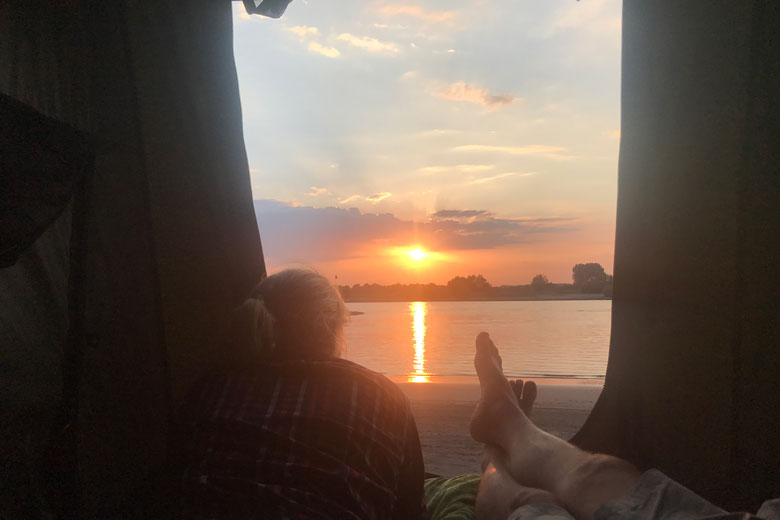- Weight: 59 kg (ladder 5 kg extra)
- Case size: 210 x 125 x 32 cm
- Mattress size: 2050 x 1195 x 50 mm
- Price: € 1849.00
Roof Top Tents, they are a trend. And I do understand. Like a snail you always have your own house with you. Sleep where you stop without the hassle of pitching a tent on a ground with holes or very wet grass Last year – around this time – I tested my first roof top tent. The Hopper from opjeautoslapen.nl. It was a fine roof top tent but not everything was cake and sunshine, resulting in a meager 5.9 (back then three stars). But I already wrote then that the people behind the Hopper were eager to learn and understood my criticism. And they have done something with it. So now there is the review of the improved and redesigned Hopper: the Hopper 2.0. Read the review and watch the video!
The Hopper is one of the three types of roof top tents from opjeautoslapen.nl. At least that is the name of the company, but actually it is better to use the new name: femkesrooftoptents.com. As you can tell from the name, the driving force behind the Hopper – and his brothers and sisters, Links below – is Femke together with her husband Tim. These two Dutchies ordered their first roof top tent on Alibaba a few years ago. It was adjusted to their wishes and further improvements were made after my review last year. The Hopper 2.0 is the first of a series of new improved Hoppers that are manufactured to Femke’s and Tim’s specifications in China.

Hard shell roof top tent
The Hopper is a so-called hard shell roof top tent. Compare it with a very large ski box. There are roughly two types of hard-shell roof top tents: the one where the upper shell as a whole rises and those where the shells are connected to each other by means of a hinge. I always call this the clam model. We can identify the Hopper in this last category.

Car roof loadcapacity
That a roof top tent does not necessarily have to be on top off a large 4 x 4 – like mine … – proves femkesrooftoptents.com because the majority of their customers (sales and rent) have a normal or compact car. Putting a roof top tent on your car is therefore not difficult; the only thing you need for it is a few strong people or a hoist. The Hopper weighs 59 kilos (without a ladder) and you just can’t lift that on your own.
The roof top tent mounts – just like a roof top box – on two loadbars on your car roof. Most cars have this option. Take a look in the car manual to see if the car roof can have this load. And also pay attention to the static load. This is the load that is allowed on the car roof when it is standing still. Often more than 300 kg so a roof top tent and two people should not be a problem.
Attaching
On the outside (and underneath so hardly visible) of the Hopper’s bottom shell is a chromed steel frame with two long aluminum beams underneath. The latter run from front to back.
The Hopper is stuck with four ‘clamps’. These clamps consist of two aluminum plates, a chromed metal plate and four bolts and nuts per clamp. Two aluminum plates go into a special slot in the aluminum beams and the metals on the underside of the roof top rack. In this case, a photo or video (see below) says it all. Once everything is in place, the Hopper is solid like a house. The good thing is that the supplier provides an excellent ratchet ring key to get the job done. The above applies to standard cars and standard roof top racks.


Front Runner Roofrack
I don’t have loadbars but a Front Runner Full Rack roofrack that is mounted on the gutter of my Toyota Landcruiser Prado 95. The rack has a size of 2160 mm long, 1260 mm wide and is 50 mm high. With its size of 2100 mm long, 1250 mm (bottom scale) wide and 320 mm high, the Hopper fits perfectly. The clamps fit just around 90 mm wide crossbars. Tightening the nuts is a pain in the butt because of the limited space between car roof roofrack. Put a towel in between!
Pitching
I like small lightweight and quick pitching tents, but as fast the Hopper… no proper tent comes close. It is a matter of loosening two straps and a Velcro securing strap on the rear, giving the upper shell a light push and two gas springs do the rest. Without having to do anything, the tent stands proudly within 30 seconds. The only thing left for me is to place the ladder at one of the three entrances. Actually, the Hopper has two real entrances: those on the sides. The third on the short side is actually a big window. The three ‘doors’ have coarse zippers and can be zipped all the way to the top. The ‘doors’ can be rolled away upwards, but you can also stretch them with metal expanders as a canopy. Once you’ve done that, you’re done.

Packing
Getting the tent back to its shell is a little slower. First you have to place two elastics between the side walls (so in the part above you also have to remove them when you use the tent). These ensure that the tent fabric folds itself inwards automatically when it is pulled down with a drawstring. However, you still have to help a little here to get all the fabric back into the shell properly. This is best done by two. The job is then done in a few minutes. Tighten the straps and you are on the road again.

Material shell
Most hard shell roof top tents have a shell made of polyester. And not without reason, because polyester is strong, resistant to UV and durable. That is why many boats are made of it. However, polyester has two drawbacks: it is relatively heavy and can continue to smell for a long time, to well… the glue and solvents used in manufacturing proces.
The Hopper shell is made of ABS. A conscious choice by Femke and Tim because ABS is a plastic with the three big advantages: It is light, easy to produce and, very important to Femke and Tim, 100% recyclable. The disadvantages are that it is less UV resistant and less strong. I take that UV resistance with a grain of salt: Thule – the roof top box giant – has been making them from ABS for years and only the really old black ones have sometimes become slightly grayer.
Regarding the strength, there is something else to report. To give the shells their strength, a reinforcement construction of metal and aluminum has been applied on the inside. The hinges and gas springs are attached to this construction. Compared to the first generation of Hoppers, something has changed here.

The hinges at the front have become larger and attached in a different way. Now the shells open slightly higher, creating more foot space. Or headroom if you want to lie the other way around. The lid has also become a bit longer, so that it falls completely over the bottom. This prevents wind and rain blowing in the closed Hopper. A rubber edge around it also helps. I noticed while driving that this extended edge should have been slightly thicker; it vibrates a bit while driving. It certainly doesn’t break; it’s more of an aesthetic thing.

Tent fabric
The tent itself is made of a 280 grams fabric with a combination of 70% polyester and 30% cotton. The inside of the fabric is coated with a PU coating to make it waterproof. You have to tape the seams for tents with a PU-coated fabric to make them 100% waterproof. All seams on the Hopper 2.0 are taped. More about this later. The tent fabric is fire retardant and available in four colors. It is a coincidence that this color also matches my car. Orange would also have been nice!

Construction
The tent is attached to the shell with a double construction. First, there is a double rain slab above and below with string in an aluminum guide rail that is attached to the steel structure of the shell. A construction that you often see at caravan awnings. Attached to this rain slab is a zipper that runs all the way around and which connects the tent to the shell. The good thing about this construction is that the tent can easily be removed from the shell if something goes wrong. For example, to repair a hole or replace the entire tent. A nice sustainable method. The whole of the construction looks neat and is solidly built.

Sleeping space
A roof top tent like the Hopper is purely designed for convenience and sleeping comfort. Not to camp in it all day. You can, by the way, in bad weather if you love each other dearly. The sleeping area is fine. The mattress is 2050 mm long by 1195 mm wide and is 50 mm thick. These are my measurements; those of the manufacturer deviate slightly. The mattress lies on a bottom of a plastic honeycomb structure, which reduced the weight of the Hopper by 6 kg. That is different from the previous version because it was then a 8 mm thick water-resistant plywood. I find it striking that the mattress on the new bottom ventilates better than on the plywood with holes cut in to it.

The highest point from the mattress to the shell is 1365 mm and therefore the Hopper 2.0 is very spacious. You can sit upright or sit on your knees and have a lot of room for moving around when dressing and undressing. There are two bags on either side of the door. I mainly use them for storing my shoes / sandals so that they do not touch the mattress. I leave the rest of the clothing in the car or at the foot end.


Mattress
The mattress is made of a high density slow foam with a washable (zipper) cover made of cotton around it. The mattress is fine for me: I am 1.69 tall and weigh 63 kg and not a woman with more pronounced hips and shoulders. My dearest weights the same, but when lying sideways found the mattress a bit to soft at her hips. In the previous Hopper we had slept for a while with a special ventilating 3D mesh under mattress and that makes that little bit extra in comfort and ventilation. So purchase this!


Mosquitos
The two doors are fitted with polyester mosquito nets with a YKK zipper on the left and right. The underside of the mesh is nice and long so that you can tuck it under your mattress. The large window is also fitted with mosquito mesh, but it has a zipper that runs around it.
The doors are also closed with a zipper and a wide flap with Velcro prevents rain from seeping in. Nice new detail is the so-called ‘peek-a-boo’ privacy screens. These are attached to the bottom and outside of the doors and prevent others from looking into the tent.


Awnings
The doors also serve as an awning. For this purpose, metal booms are supplied with the Hopper. You can hook these into rings on the corners of the doors. The other end go’s in a hole in the aluminum rim of the bowl. The construction has been improved with the Hopper 2.0 because now a metal plate with an extra hole has been placed. This prevents wearing out the holes in the relatively soft aluminum.


It is great that on two thirds the booms have a triangular kink, so that rain will not drip from the boom on to the tent. In addition to the short ones, two extra long booms are supplied for the large window; this way your view is virtually unobstructed.

The awnings have a rain flap that also serves as a sun visor with a lot of sun. The awnings are equipped with a metal strip to give the awnings the necessary rigidity. There is no sagging. To be able to roll away the awnings and the mesh, the Hopper has a good ‘tying down system’ that can also be used with cold fingers.

A plastic window is supplied for the doors and the giga window so that you can still look outside when the weather is bad. You place this window with Velcro on the spot where otherwise the awning is attached.


Roof Top Tent Live
In practice, the Hopper works well. It is easy to set up and with the ladder you can quickly crawl into your bed. Thanks to the awnings, you can still do this well protected from rain. But … there are also roof top tents where you can crawl underneath – so absolutely free from wind and rain – into your tent. That is not the case with the Hopper. Inside the Hopper there is enough space for two big adults with some clothes and a few books. There are four hooks in the inside of the lid where you can attach a luggage net.
Because the shell has a fair amount of volume, you can leave at least two sleeping bags and pillows in the Hopper when you relocate. And the ladder also fits. In my case, I put the ladder in the back of the car, leaving room for the children’s sleeping bags and two sleeping pads. This makes setting up their tent much faster.


Black: nice and warm!
The shell of femkesrooftoptents.com are always black. This is in contrast to the usually white polyester roof top tents. In practice, white is better for warm areas. I have noticed that black is not that bad for Northern Europe. Especially in early spring and late fall, a dark tent is really warmer. During really hot days it gets hot in the roof top tent. Not only when you stand still but also on the road. Yet I notice that the heat is gone quickly as soon as the tent is up and the sun goes down. This high up you seem to have just a little more wind to cool the tent faster. And a personal note: I think white is terrible, as if you have a boat on your car roof.
Wildlife spotting
Nice side effect of a roof top tent turned out during wild camping. I am in my roof top tent and the mesh is open. Apparently animals don’t see me as a threat that high up, because the number of hares and birds that roamed around the tent didn’t notice me. In a roof top tent you literally get closer to nature; you bring your own mobile wildlife spotting hut.

Weather and wind
When looking for the right spot to camp there are a few things to take into account: view from the roof top tent and the wind direction (and that your car is a bit level of course). In good weather the latter is not important and I opt for the view. With more wind and rain I put the tent with the hinges in the wind. This way wind and rain crash on the strongest point of the tent. I then use the large window with awning to enter sheltered. When there is a lot of wind the tent suffers a bit from flapping canvas, but … after all, it remains a tent! You can also place the elastic cords that you use when folding in; then it flaps considerably less. Just keep it in mind if you get up.
Ventilation and Waterproof
The ventilation is great as long as you open an awning partly. The fact that the upper shell is nicely lined on the inside prevents condensation drops falling on your head. And while I’m talking about drops … is the tent waterproof? That is perhaps the biggest improvement compared to the first Hopper. All flaws in the stitching, taping and fabrication have been eliminated: 100% waterproof!


The verdict
The Hopper is easy to fit on any car. It has also proven to be practical in use. The materials and construction are good. The mattress is a bit on the soft side and that is why I recommend that you purchase the 15 mm thick ventilating 3D Mesh under mattress. Not only does it sleep better, it also extends the lifespan of the mattress and ensures that the honeycomb bottom can do its job even better. The sleeping space is fine and the inside space nice and high. The volume is large so that bedding, pillows, extra sleeping bags and blankets can simply remain in place when relocating. The Hopper is sufficiently windproof and 100% waterproof. Keep in mind that with awnings open and wind and rain, some might blow in. The strongest point of the Hopper is the price: € 1849 is pretty sharp for a hardshell roof top tent with all supplied accessories. Thanks to the improvements, the Hopper 2.0 now scores 8.4 out of 10 points!
Information: www.femkesrooftoptents.com
More roof top tent reviews here!
